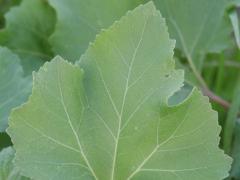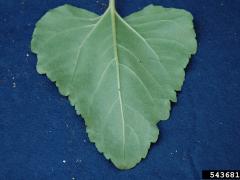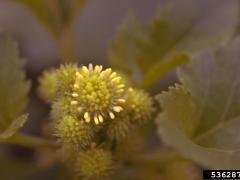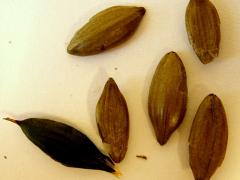Invasive Species: Xanthium strumarium, Common Cocklebur
Common cocklebur is an invasive annual herb, with several regional varieties, some possibly native to North America. Historically, the seeds were eaten by the Carolina parakeet, which is now extinct. Plants can reach 5 ft. (1.5 m) tall with thick, reddish or black spotted stems. Leaves are alternate, triangular, weakly 3-lobed and 1.2 to 7 in. (3 to 18 cm) long. Flowering occurs in July to October when flowers develop in the axils of the leaves. Fruit are ellipsoid burs. Burs are 0.6 to 1.4 in. (1.5 to 3.5 cm) long, green to yellowish brown, and covered with projecting, stout prickles. Cocklebur occurs in ditches, fields, riparian areas, pastures, croplands, seasonal wetlands, and other disturbed areas. Cocklebur is found worldwide. Some cocklebur species may be native to the Americas, but it has caused many problems in agriculture and both seeds and seedlings are toxic to livestock, making it an undesirable weed.
What are invasive species and why should we be concerned about them?
Taxonomy: Scientific and Common Names for This Species
Asterales > Asteraceae > Xanthium strumarium L.
Synonym(s): cocklebur, cockleburr, rough cocklebur
Xanthium strumarium – USDA PLANTS Profile
Distribution Maps
Common cocklebur – The reported distribution of this invasive species across the United States (Source: Invasive Plant Atlas of the United States)
Up-to-the-minute distribution maps and why they are important
Reporting This Invasive Species
What is the best way and place to report the occurrence of an invasive species?
How to report an invasive species sighting to EDDMapS – Early Detection & Distribution Mapping System
EDDMapS – Report an invasive species to EDDMapS
Cooperative Extension Offices – Find your local Cooperative Extension office on this map provided by USDA.
How to Identify
This invasive species can be identified by looking for the characteristics described in the paragraphs that follow.
Plant
Plants can reach 5 ft. (1.5 m) tall with thick, reddish or black spotted stems.
 |
 |
| David J. Moorhead, University of Georgia, bugwood.org | Robert Videki, Doronicum Kft., bugwood.org |
Foliage
Leaves are alternate, triangular, weakly 3-lobed, and 1.2 to 7 in. (3 to 18 cm) long.
 |
 |
| Robert Videki, Doronicum Kft., bugwood.org | Bruce Ackley, Ohio State University, bugwood.org |
Flower
Flowering occurs in July to October when flowers develop in the axils of the leaves.
 |
 |
| Phil Westra, Colorado State University, bugwood.org | David J. Moorhead, University of Georgia, bugwood.org |
Fruit
Fruit are ellipsoid burs. Burs are 0.6 to 1.4 in. (1.5 to 3.5 cm) long, green to yellowish brown, and covered with projecting, stout prickles.
 |
 |
| John M. Randall, The Nature Conservancy, bugwood.org | Jan Samanek, State Phytosanitary Administration, bugwood.org |
Native Species That Can Resemble Common Cocklebur
– Images at invasive.org
| bugwood.org | bugwood.org |
– Images at invasive.org
| bugwood.org | bugwood.org |
Additional Images for Common Cocklebur
Common cocklebur – Images at Invasive.org
Additional Information, Biology, Control and Management Resources
Control and management recommendations vary according to individual circumstances. Location, habitat, weather, and a variety of other conditions are factors that help determine the best treatment choice. To find the safest and most effective treatment for your situation, consult your state’s land-grant institution. If you will use chemicals as part of the control process, always refer to the product label.
United States Land-Grant University System – Find your land-grant university’s college of agriculture, Cooperative Extension office, or other related partner on this map provided by USDA.
Element Stewardship Abstract – The Nature Conservancy
Identification: Weed Photo Gallery – IPM Online, University of California
Invasive Species Compendium (Beta) – cabi.org
USGS Weeds in the West project: Status of Introduced Plants in Southern Arizona Parks – USGS National Park Service
Xanthium strumarium – Pacific Island Ecosystems at Risk (PIER)
